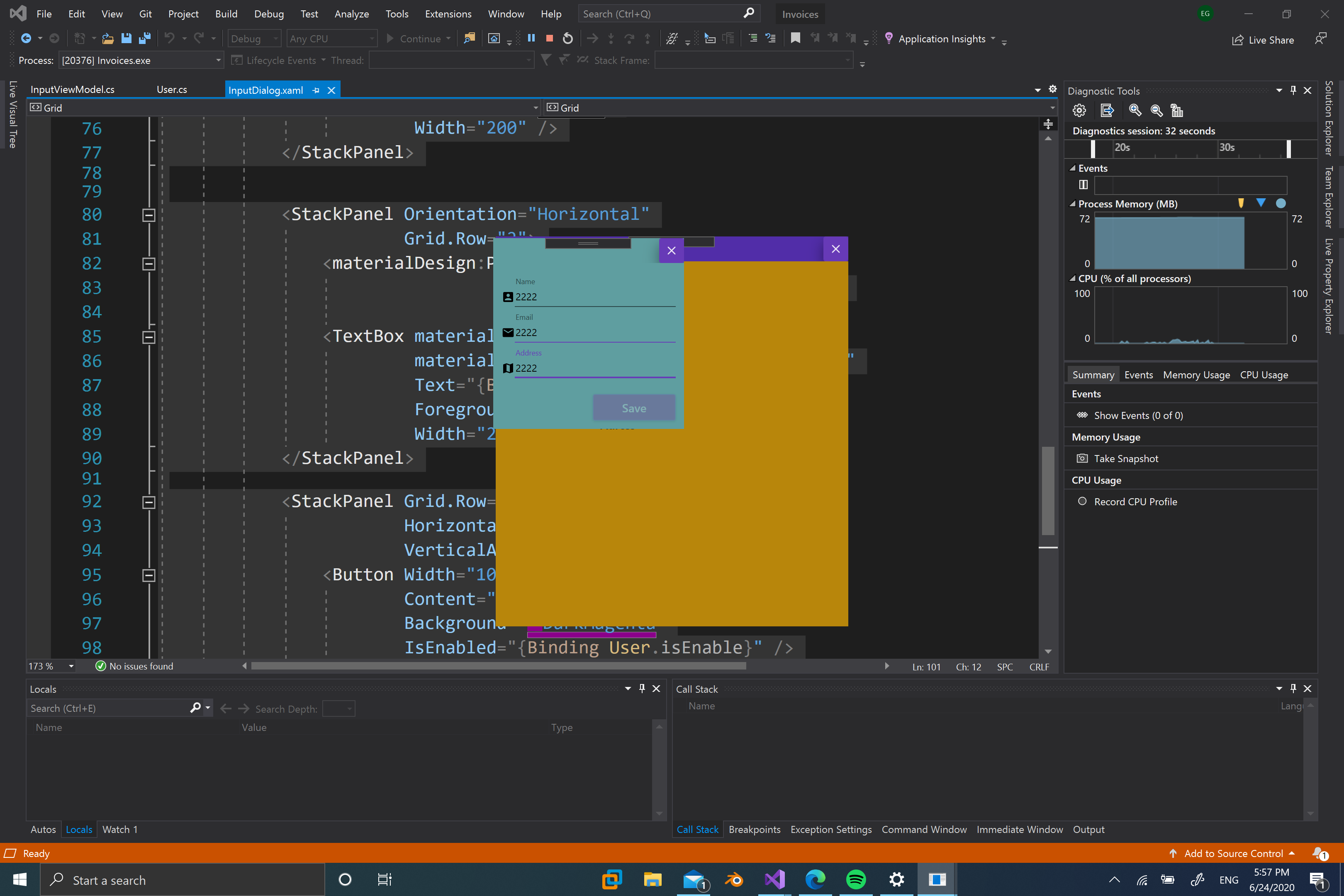Hello everyone.
I want to get some clarification about MVVM a possibly help me with a WPF app
I have this class, witch represent a User
public int Id { get; set; }
private string _Name;
public string Name {
get { return _Name; }
set {
if (_Name != value) {
_Name = value;
RaisePropertyChanged();
Validate();
}
}
}
private string _Email;
public string Email {
get { return _Email; }
set {
if (_Email != value) {
_Email = value;
RaisePropertyChanged();
Validate();
}
}
}
private bool _isEnable;
public bool isEnable {
get { return _isEnable; }
set {
if (_isEnable != value) {
_isEnable = value;
RaisePropertyChanged();
}
}
}
private string _Address;
public string Address {
get { return _Address; }
set {
if (_Address != value) {
_Address = value;
RaisePropertyChanged();
Validate();
}
}
}
private void Validate() {
if (string.IsNullOrEmpty(_Name) || string.IsNullOrEmpty(_Email) || string.IsNullOrEmpty(_Address)) {
isEnable = false;
} else {
isEnable = true;
}
}
public User() { }
}
}
That I use in a viewModel like
public User User { get; set; }
public CloseDialogCommand CloseDialogCommand { get; set; }
public SaveCommand SaveCommand { get; set; }
public InputViewModel() {
User = new User();
SaveCommand = new SaveCommand(this);
CloseDialogCommand = new CloseDialogCommand(this);
}
public void Save(object user) {
}
internal void CloseDialog(Window window) {
window.Close();
}
}
}
And finally I se in my view
<Window.Resources>
<vm:InputViewModel x:Key="vm" />
</Window.Resources>
<Grid DataContext="{StaticResource vm}">
<Grid.RowDefinitions>
<RowDefinition Height="auto" />
<RowDefinition Height="*" />
</Grid.RowDefinitions>
<Border x:Name="WindowCommandBar"
Background="Transparent"
MouseDown="WindowCommandBar_MouseDown">
<Grid>
<materialDesign:ColorZone Mode="Custom">
<StackPanel HorizontalAlignment="Right">
<Button materialDesign:ShadowAssist.ShadowDepth="Depth4"
Width="30"
Height="30"
Padding="0"
Command="{Binding CloseDialogCommand}"
CommandParameter="{Binding ElementName=input}">
<materialDesign:PackIcon Kind="WindowClose" />
</Button>
</StackPanel>
</materialDesign:ColorZone>
</Grid>
</Border>
<Grid Grid.Row="1"
Margin="10">
<Grid.RowDefinitions>
<RowDefinition Height="auto" />
<RowDefinition Height="auto" />
<RowDefinition Height="auto" />
<RowDefinition Height="*" />
</Grid.RowDefinitions>
<StackPanel Orientation="Horizontal">
<materialDesign:PackIcon Kind="UserBox"
VerticalAlignment="Bottom"
Margin="0 0 0 4"/>
<TextBox materialDesign:HintAssist.Hint="Name"
materialDesign:HintAssist.IsFloating="True"
Text="{Binding User.Name}"
Foreground="Black"
Width="200" />
</StackPanel>
<StackPanel Orientation="Horizontal" Grid.Row="1">
<materialDesign:PackIcon Kind="Email"
VerticalAlignment="Bottom"
Margin="0 0 0 4" />
<TextBox materialDesign:HintAssist.Hint="Email"
Text="{Binding User.Email}"
materialDesign:HintAssist.IsFloating="True"
Foreground="Black"
Width="200" />
</StackPanel>
<StackPanel Orientation="Horizontal"
Grid.Row="2">
<materialDesign:PackIcon Kind="Map"
VerticalAlignment="Bottom"
Margin="0 0 0 4" />
<TextBox materialDesign:HintAssist.Hint="Address"
materialDesign:HintAssist.IsFloating="True"
Text="{Binding User.Address}"
Foreground="Black"
Width="200" />
</StackPanel>
<StackPanel Grid.Row="3"
HorizontalAlignment="Right"
VerticalAlignment="Bottom">
<Button Width="100"
Content="Save"
Background="DarkMagenta"
IsEnabled="{Binding User.isEnable}" />
</StackPanel>
</Grid>
</Grid>
Ok my questions is, every documentation or youtube video that I see, they declare each string in the ViewModel and connect the ViewModel to the view (becouse all the properties are there and the the validation). What is te purpose of the Model then?, if I am respiting the same code I can put my validation in the model and that's it right?
My teacher, respond me this:
Instead of having the texbox binding to the User object, try creating independent string properties
In your XAML, use these string properties instead.
Now what I am doing in my app is disable the button, until the user fields everything, but the problem is that I have to press Tab on my keyboard so that the PropertyChange coud be fired



